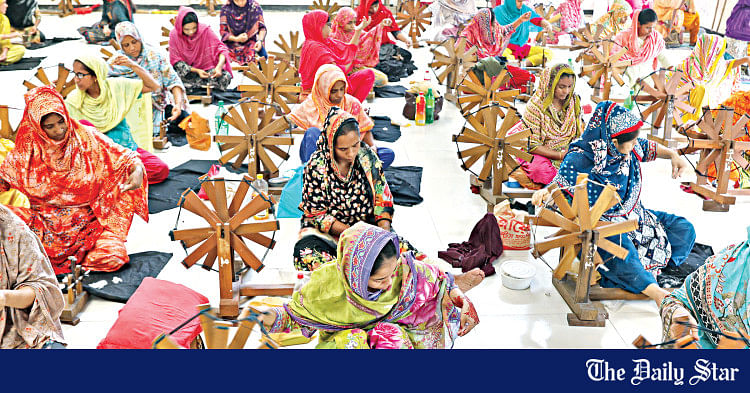Muslin’s revival weaves past into present
A centuries-old fabric once lost to history is being revived -- and with it, a new generation of artisans, mostly women, are weaving their way into the economy.
Photo: Ibrahim Khalil Ibu
On a golden summer morning in Rupganj, Narayanganj, the sound of handlooms echoes from tin-roofed sheds nestled amid winding village paths and open fields. Inside, women and men sit in quiet focus, spinning delicate threads. Here, in the heart of what was once Bengal's muslin belt, a fabric that disappeared nearly two centuries ago is being reborn -- and with it, the livelihoods of hundreds of rural artisans.
The Dhakai muslin revival project, formally titled Bangladesh's Golden Heritage: Muslin Yarn Making Technology and Revival of Muslin Fabrics, was launched in 2018 with a budget of Tk 12.1 crore. Its goals were ambitious: to rediscover the lost phuti karpas cotton, retrain weavers in long-forgotten techniques, and re-establish muslin as a symbol of national pride -- and rural prosperity.
What began as a heritage restoration initiative has evolved into a grassroots economic movement, creating employment, empowering women, and anchoring a new kind of rural artisan economy in the legacy of an ancient craft.
For nearly 200 years, the threads of muslin lay broken. Once draped across Mughal emperors and traded across Europe and the Middle East, Dhakai muslin collapsed under the combined weight of colonial violence, industrial competition, and economic neglect. British policies in the 18th and 19th centuries, including punitive taxation, import substitution, and, according to some historical accounts, deliberate sabotage, brought the muslin industry to its knees. The decline of the Mughal Empire and the disappearance of phuti karpas, the rare cotton plant used in muslin, sealed its fate.
Not until 2014 did serious efforts begin to revive it. That year, the Ministry of Textiles and Jute issued a directive: bring back muslin. Four years later, the project was formally launched under the Bangladesh Handloom Board. A research committee was formed, including experts from Bangladesh Textile University, Rajshahi University, BTMC, and the Cotton Development Board.
"We launched this project to revive our heritage and golden past," said Md Ayub Ali, the project's director. "And we worked with that goal in mind."
The first challenge was scientific: to locate and cultivate phuti karpas again. But equally vital was the rediscovery of ultra-fine hand-spinning techniques -- the kind once capable of producing yarn counts above 500, so fine it could pass through a signet ring.
In Chandina and Debidwar in Cumilla, researchers found ageing artisans still producing low-count yarns on foot-powered spindles. Through rigorous training and patient mentoring, many have now reached counts as high as 731, approaching the legendary fineness of historical muslin.
Beyond historical restoration, the project has offered a lifeline to hundreds of rural women who had little or no access to income. Among them is Marjia Begum, 18, from a small village near Narayanganj.
"I had to stop school during the coronavirus lockdown. We just couldn't afford anything anymore," she said. Having studied up to class 9, she faced a future filled with economic uncertainty. "I was not in any job, and I had no skills. I used to just sit at home, worried all the time," she recalled.
Her life changed when she was selected for muslin training under the revival initiative. "At first, I didn't even understand what muslin really was," she said, laughing. "But the trainers were patient. Slowly, I began to love it."
Marjia now earns Tk 550 a day -- enough to support her family and save for the future. "It's not just a job," she said. "This is dignity. I can help my parents. I feel important."
Like Marjia, most of the 327 women trained so far had previously been engaged in unpaid domestic work. "Out of 327 women weavers, 300 were in domestic work, which we do not value economically," said Ayub Ali. "They've come out, taken training, and are now contributing. This is a major achievement in women's empowerment."
The structure of the workday, typically from 7 am to 2 pm, allows women to balance paid work with household responsibilities. Many bring their children to the muslin centres, where they play nearby.
Jayeda Akter Joba, 24, lives near Dhaka Muslin House in Rupganj. "I finished higher secondary school, but after that, I couldn't study further. We often struggled to eat even once a day," she said. Curious about the training, she joined. "I'd read that kings and queens once wore muslin. I never thought I'd help make it."
After six months of training, Joba now earns a stable income. "I support my family with my husband, pay for my children's expenses, and I no longer feel like a burden."
WEAVING SKILL, HISTORY AND DIGNITY
Mohsina Akhter, 33, began her career as a domestic help in Chandina, Cumilla. Today, she is a supervisor and trainer at the Dhaka Muslin House. "It took me two to three years of practice to master the technique," she said. Now earning Tk 16,800 per month, she trains other women and supports her family. "I feel proud, not just for what I make, but for what I pass on."
Aasia Begum, 31, worked for years as a Jamdani weaver before transitioning to muslin. "Jamdani is easier," she explained. "Muslin is much more delicate. Everything is done by hand -- spinning, weaving -- and it takes a long time. I often get back pain from sitting for hours."
Despite the difficulties, Aasia has completed three full muslin pieces. "It's something our ancestors were famous for. I'm proud to be part of this history."
Yet even pride has its limits. "If this project continues and our income increases, we'll be more empowered and the muslin industry will rise again," she said.
That tension -- between cultural legacy and economic viability -- is echoed by other artisans.
Sabuj Mia, a senior weaver, said: "We're proud to bring muslin back, but for us artisans to stay committed, we need fair wages that match the time and effort this work demands. If income grows steadily, muslin won't just survive, it will thrive."
He added that many artisans are the sole breadwinners in their families. "We can't keep going just on pride. We need consistent support and better pay. Then this heritage won't be a burden -- it'll be a future."
The project has achieved symbolic milestones. In March 2021, muslin received geographical indication (GI) certification. In July the same year, it won the national Public Administration Medal (institutional category), recognising its role in reviving a critical piece of Bangladesh's cultural identity.
The Dhaka Muslin House, established in Tarabo along the Shitalakshya River, once a thriving zone of muslin trade, now functions as both a production hub and a living museum.
In the first phase, artisans produced 58 pieces of muslin cloth, including 27 sarees -- some complete, others still in progress, as well as scarves and veils. These pieces are not being sold commercially, but serve as research and exhibition material.
A second phase began in March 2025 and will run until mid-2027. It aims to refine cotton varieties, improve pre-weaving processes, and train private entrepreneurs for future scale-up. "We plan to transfer the project to private hands for long-term commercial production, both nationally and globally," said Ali.
Still, concerns linger over job security. Many workers remain under project-based contracts, with uncertain continuity. During funding gaps or administrative lulls, some artisans have left for garment factories, lured by more stable income. For muslin to flourish, workers say, it needs not just pride but protection.
A FABRIC OF THE FUTURE
Today, muslin is more than a cloth. It is a return on cultural investment, a rediscovery of skill, dignity, and economic value rooted in tradition. The revival of Dhakai muslin illustrates what heritage restoration can achieve when paired with inclusive employment, targeted training, and sustained institutional support.
And in the fingers of women like Marjia, the legacy of Bengal's most exquisite fabric is being rewoven -- not just into cloth, but into lives, livelihoods, and a future stitched with purpose.
While the term "muslin" continues to be used commercially by fashion brands, much of it is in name only, Md Monzur Hossain, professor of Botany at Rajshahi University and a member of the muslin research team, said. "Muslin is still being marketed by various fashion companies, but mostly as a trade name because the word 'muslin' has commercial appeal," he said. "If you use the name, it sells."
But true Dhakai muslin, he emphasised, must meet specific criteria in both material and technique. "Authentic Dhakai muslin must be made entirely of cotton and woven with yarn of a specific count," he said, adding that the revival project even developed a new spinning wheel to meet these traditional standards.
"Whether the yarn is 300 count and produced locally or imported -- these are critical considerations," Hossain added. "If these criteria aren't met, it can't be called genuine Dhakai muslin."



 www.newagebd.net
www.newagebd.net




